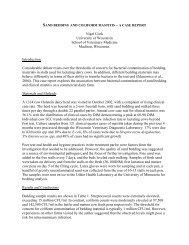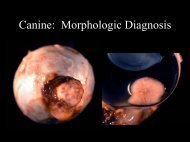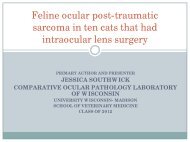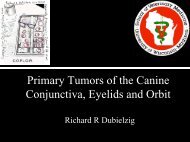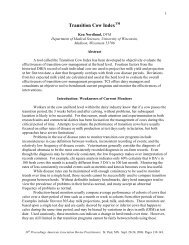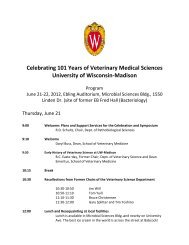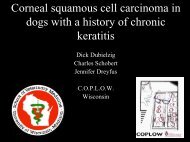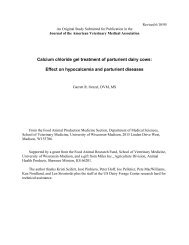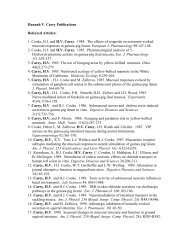Subacute Ruminal Acidosis in Dairy Herds - University of Wisconsin ...
Subacute Ruminal Acidosis in Dairy Herds - University of Wisconsin ...
Subacute Ruminal Acidosis in Dairy Herds - University of Wisconsin ...
You also want an ePaper? Increase the reach of your titles
YUMPU automatically turns print PDFs into web optimized ePapers that Google loves.
Preconvention Sem<strong>in</strong>ar 7A: <strong>Dairy</strong> Herd Problem Investigation Strategies:Lameness, Cow Comfort, and <strong>Rum<strong>in</strong>al</strong> <strong>Acidosis</strong>particles and the TMR refusal is 24% long particles, then sort<strong>in</strong>g is probably not a major issue.But if the TMR refusal conta<strong>in</strong>s >28% long particles, then this is cause for concern.The most common cause <strong>of</strong> excessive TMR sort<strong>in</strong>g is the <strong>in</strong>clusion <strong>of</strong> unprocessed, coarse,dry baled hay <strong>in</strong> a TMR. Despite the claims <strong>of</strong> manufacturers, most TMR mixers (except forsome vertical mixers) are unable to adequately reduce the particle size <strong>of</strong> coarse dry hay.Process<strong>in</strong>g this hay before add<strong>in</strong>g it to the mixer is <strong>of</strong>ten necessary. In many cases, the dry haycan be elim<strong>in</strong>ated from the TMR, provided there are adequate long particles from haylage andcorn silage. It seems paradoxical, but the risk for SARA <strong>in</strong> a herd can sometimes be lowered byremov<strong>in</strong>g the baled hay from the TMR.Inadequate adaptation to highly fermentable, high carbohydrate diets. In theory, cows <strong>in</strong>early lactation should be particularly susceptible to SARA if they are poorly prepared for thelactation diet they will receive. <strong>Rum<strong>in</strong>al</strong> adaptation to diets high <strong>in</strong> fermentable carbohydratesapparently has two key aspects – microbial adaptation (particularly the lactate-utiliz<strong>in</strong>g bacteria,which grow more slowly than the lactate-produc<strong>in</strong>g bacteria) and rum<strong>in</strong>al papillae length (longerpapillae promote greater VFA absorption and thus lower rum<strong>in</strong>al pH) (Dirksen et al., 1985).Beef feedlots recognize the importance <strong>of</strong> gradually <strong>in</strong>troduc<strong>in</strong>g steers to higher gra<strong>in</strong> diets(Radostits et al., 1994).The known pr<strong>in</strong>ciples <strong>of</strong> rum<strong>in</strong>al adaptation suggest that <strong>in</strong>creas<strong>in</strong>g gra<strong>in</strong> feed<strong>in</strong>g toward theend <strong>of</strong> the dry period should decrease the risk for SARA <strong>in</strong> early lactation cows. However, arecent field study <strong>in</strong> TMR-fed herds found no effect <strong>of</strong> dry period feed<strong>in</strong>g on early lactationrum<strong>in</strong>al pH. And rum<strong>in</strong>al pH <strong>in</strong> this study was unexpectedly lower <strong>in</strong> cows at 106 average days<strong>in</strong> milk compared to cows at 15 average days <strong>in</strong> milk (Garrett et al., 1997). These results suggestthat high dry matter <strong>in</strong>take is a more important risk factor for SARA than rum<strong>in</strong>al adaptationproblems <strong>in</strong> dairy herds. Also, a controlled study <strong>in</strong> component-fed cows found no positiveeffect <strong>of</strong> <strong>in</strong>creased gra<strong>in</strong> feed<strong>in</strong>g dur<strong>in</strong>g the dry period on early lactation rum<strong>in</strong>al pH or drymatter <strong>in</strong>take (Andersen et al., 1999). These results suggest that the practical impacts <strong>of</strong> rum<strong>in</strong>aladaptation may be small or even <strong>in</strong>consequential <strong>in</strong> dairy herds - particularly when cows are feda TMR after calv<strong>in</strong>g.Prevention <strong>of</strong> <strong>Subacute</strong> <strong>Rum<strong>in</strong>al</strong> <strong>Acidosis</strong> <strong>in</strong> <strong>Dairy</strong> <strong>Herds</strong>The basic pr<strong>in</strong>ciples <strong>of</strong> prevent<strong>in</strong>g SARA <strong>in</strong> dairy herds have been discussed above and<strong>in</strong>clude limit<strong>in</strong>g the <strong>in</strong>take <strong>of</strong> rapidly fermentable carbohydrates, provid<strong>in</strong>g adequate rum<strong>in</strong>albuffer<strong>in</strong>g, and allow<strong>in</strong>g for rum<strong>in</strong>al adaptation to high gra<strong>in</strong> diets. However, I expect SARA torema<strong>in</strong> an important dairy cow problem even when these pr<strong>in</strong>ciples are understood and applied,because the l<strong>in</strong>e between optimal milk production and over-feed<strong>in</strong>g gra<strong>in</strong> is exceed<strong>in</strong>gly f<strong>in</strong>e. Inmany dairy herd situations, milk production can appear to be temporarily <strong>in</strong>creased by overfeed<strong>in</strong>ggra<strong>in</strong> and caus<strong>in</strong>g SARA; however, the long-term health and economic consequences <strong>of</strong>this approach are devastat<strong>in</strong>g. Any additional nutritional <strong>in</strong>terventions that might prevent SARAwithout limit<strong>in</strong>g gra<strong>in</strong> feed<strong>in</strong>g are highly desirable. Several <strong>of</strong> these approaches are summarizedbelow.Enhanc<strong>in</strong>g rum<strong>in</strong>al lactate utilizers. An important aspect <strong>of</strong> ma<strong>in</strong>ta<strong>in</strong><strong>in</strong>g a stable rumenenvironment is ma<strong>in</strong>ta<strong>in</strong><strong>in</strong>g a balance between lactate production and lactate utilization bybacteria that convert lactate to less dangerous VFA. Enhanc<strong>in</strong>g rum<strong>in</strong>al lactate utilizers reducesthe risk for rum<strong>in</strong>al acidosis (particularly the acute form <strong>of</strong> rum<strong>in</strong>al acidosis). Supplementation<strong>University</strong> <strong>of</strong> Wiscons<strong>in</strong>, School <strong>of</strong> Veter<strong>in</strong>ary Medic<strong>in</strong>e, 2015 L<strong>in</strong>den Drive, Madison, WI 53706110



